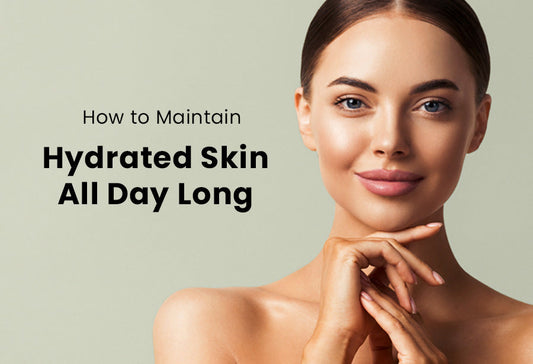
Mastering Double Cleansing: Tailoring the Technique to Your Skin Type
Double cleansing has gained immense popularity in the realm of skincare for its ability to provide a thorough and effective cleanse. It involves using two different types of cleansers consecutively to remove makeup, impurities, and excess oil, ensuring a clean canvas for the rest of your skincare routine. While the concept remains consistent, the approach to double cleansing can vary significantly based on your skin type. In this blog, we will explore the art of double cleansing and how to customize the technique to suit different skin types for optimal results.
Understanding Double Cleansing
Double cleansing involves the use of an oil-based cleanser followed by a water-based cleanser. The first step with an oil-based cleanser helps dissolve makeup, sunscreen, and sebum, while the second step with a water-based cleanser targets any remaining impurities, leaving the skin clean and refreshed.
The Benefits of Double Cleansing
- Thorough Cleansing: Double cleansing ensures the removal of all traces of makeup, dirt, and pollutants from the skin’s surface and pores.
- Improved Skincare Penetration: By eliminating impurities, your subsequent skincare products can penetrate the skin more effectively, maximizing their benefits.
- Reduced Breakouts: Double cleansing helps prevent clogged pores and reduces the likelihood of breakouts, especially for acne-prone skin.
- Brighter Complexion: A clean canvas allows your skin to look brighter and more radiant.
Double cleansing is an effective skincare technique used to thoroughly remove makeup, sunscreen, dirt, and impurities from the skin. It involves using two different types of cleansers in succession to ensure a deep and thorough cleanse. Double cleansing is particularly beneficial for those who wear heavy makeup or sunscreen or have oily and acne-prone skin. Here’s how to double cleanse effectively:
Step 1: Choose the Right Cleansers
For double cleansing, you will need two types of cleansers:
- Oil-Based Cleanser: The first step involves using an oil-based cleanser to dissolve and lift away oil-based impurities such as makeup, sunscreen, and excess sebum. Look for a gentle oil cleanser that suits your skin type. Common options include cleansing oils, cleansing balms, or micellar water with an oil-based formula.
- Water-Based Cleanser: The second step is to use a water-based cleanser to wash away water-based impurities like sweat and dirt. Choose a gentle, foaming, or gel-based cleanser suitable for your skin type. Look for one that is free of harsh ingredients and doesn’t strip the skin of its natural moisture.
Step 2: Start with Dry Hands and Face
Begin the double cleansing process with dry hands and a dry face. This allows the oil-based cleanser to break down and dissolve makeup and sunscreen effectively.
Step 3: Apply the Oil-Based Cleanser
Take a sufficient amount of the oil-based cleanser onto your dry palms and gently massage it onto your dry face using circular motions. Pay extra attention to areas with heavy makeup, such as the eyes and lips, to ensure thorough cleansing.
Step 4: Emulsify with Water
After massaging the oil-based cleanser onto your face, wet your hands with a little water, and continue to massage your face. The water will emulsify the oil cleanser, turning it milky and easier to rinse off.
Step 5: Rinse Off the Oil-Based Cleanser
Thoroughly rinse off the oil-based cleanser with lukewarm water. Ensure that all traces of makeup, sunscreen, and oil are removed from your skin.
Step 6: Apply the Water-Based Cleanser
Now that the oil-based cleanser has removed the surface impurities, it’s time to use the water-based cleanser. Take an adequate amount of the water-based cleanser and gently massage it onto your damp face, creating a lather.
Step 7: Cleanse and Rinse
Massage the water-based cleanser onto your face using gentle circular motions. Pay attention to all areas to ensure a thorough cleanse. Then, rinse your face with lukewarm water to remove the water-based cleanser.
Step 8: Pat Dry and Continue with Skincare
After double cleansing, pat your face dry with a clean towel. At this point, your skin should feel clean, refreshed, and ready for the rest of your skincare routine, such as applying toner, serums, moisturizers, and sunscreen (in the morning).
Frequency of Double Cleansing:
Double cleansing is typically recommended in the evening to remove makeup, sunscreen, and other impurities accumulated throughout the day. In the morning, a single cleanse with a water-based cleanser is usually sufficient.
Customize Your Double Cleansing Routine:
Adjust the amount and type of cleansers based on your skin type and the level of makeup or sunscreen you wear. If you have sensitive or dry skin, choose gentle cleansers to avoid irritation or over-drying. For oily or acne-prone skin, consider using a gel-based or foaming water-based cleanser to help remove excess sebum effectively.
By incorporating double cleansing into your skincare routine, you can enjoy a deeply cleansed complexion, free from impurities and better prepared for the application of subsequent skincare products. Remember that consistency is key, and adapting the process to suit your skin’s needs will help you achieve optimal results.
Let’s delve into how to tailor the double cleansing technique based on different skin types:
Double Cleansing for Dry Skin
Dry skin tends to be more sensitive and may experience increased dehydration. When double cleansing for dry skin, it’s essential to use gentle products that don’t strip the skin of its natural oils.
Step 1: Oil-Based Cleanser – Look for a nourishing oil or balm cleanser containing ingredients like jojoba oil, almond oil, or rosehip oil. These oils effectively break down makeup and impurities while providing moisture to the skin.
Step 2: Cream or Milk Cleanser – Follow up with a mild, cream-based or milk cleanser to complete the double cleansing process. Opt for a product that contains hydrating ingredients like hyaluronic acid or glycerin, which will replenish moisture without causing dryness.
Double Cleansing for Oily Skin
Oily skin types are prone to excess sebum production and clogged pores. Double cleansing can be particularly beneficial in controlling oiliness and preventing breakouts.
Step 1: Oil-Based Cleanser – Contrary to the belief that using oil on oily skin will worsen the condition, an oil-based cleanser can actually help dissolve excess sebum and impurities. Look for lightweight, non-comedogenic oils like grapeseed oil or tea tree oil.
Step 2: Gel or Foaming Cleanser – Follow up with a gel or foaming cleanser that contains salicylic acid or tea tree oil to combat acne and minimize pores. This second step will ensure a thorough cleanse while keeping excess oil under control.
Double Cleansing for Combination Skin
Combination skin involves having oily areas, typically around the T-zone (forehead, nose, and chin), and dry or normal skin on the cheeks. The goal of double cleansing for combination skin is to balance oil production while keeping the skin hydrated.
Step 1: Oil-Based Cleanser – Use an oil cleanser that is well-balanced and suits combination skin, containing ingredients like argan oil or apricot kernel oil. These oils help break down makeup and impurities without over-drying the skin.
Step 2: Gel or Milk Cleanser – For the second step, choose a mild gel or milk cleanser that hydrates the dry areas while keeping excess oil at bay. Avoid overly harsh cleansers, as they can exacerbate dryness in some areas.
Double Cleansing for Sensitive Skin
Sensitive skin requires extra care to prevent irritation and redness. When double cleansing for sensitive skin, choose products with soothing and calming properties.
Step 1: Micellar Water or Gentle Oil Cleanser – Start with micellar water or a gentle oil cleanser containing chamomile or calendula extract. These ingredients can help soothe and reduce inflammation while effectively removing makeup and impurities.
Step 2: Cream or Non-Foaming Cleanser – Follow up with a cream or non-foaming cleanser that is free of fragrances and harsh chemicals. Look for calming ingredients like aloe vera or cucumber extract to maintain the skin’s delicate balance.
Conclusion
Double cleansing is a versatile technique that can be tailored to suit various skin types, providing numerous benefits such as thorough cleansing, improved skincare absorption, and reduced breakouts. By understanding your skin type and selecting the right products for each step of the double cleansing process, you can optimize the results and enhance your overall skincare routine. Remember that consistency is key, and always listen to your skin’s needs. With a personalized double cleansing approach, you’ll be well on your way to achieving a radiant and healthy complexion.








